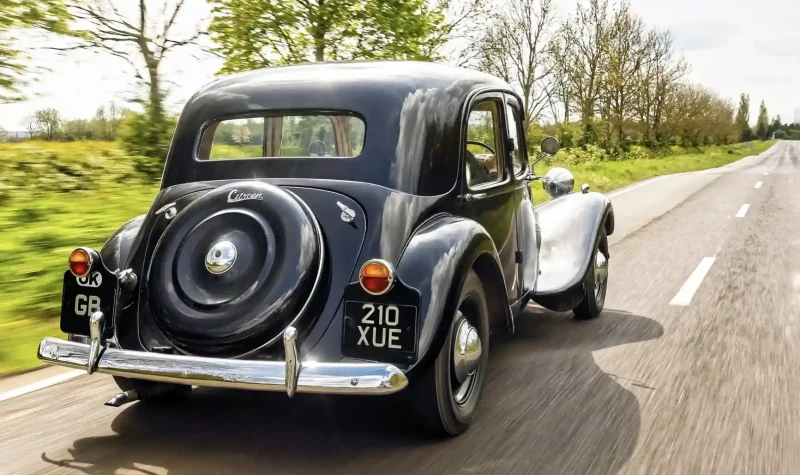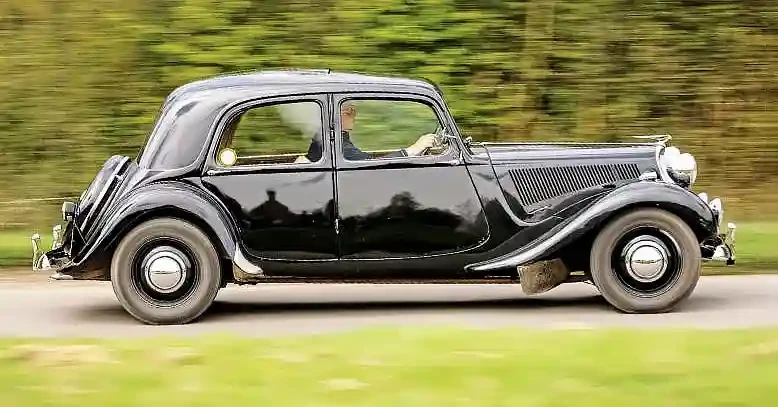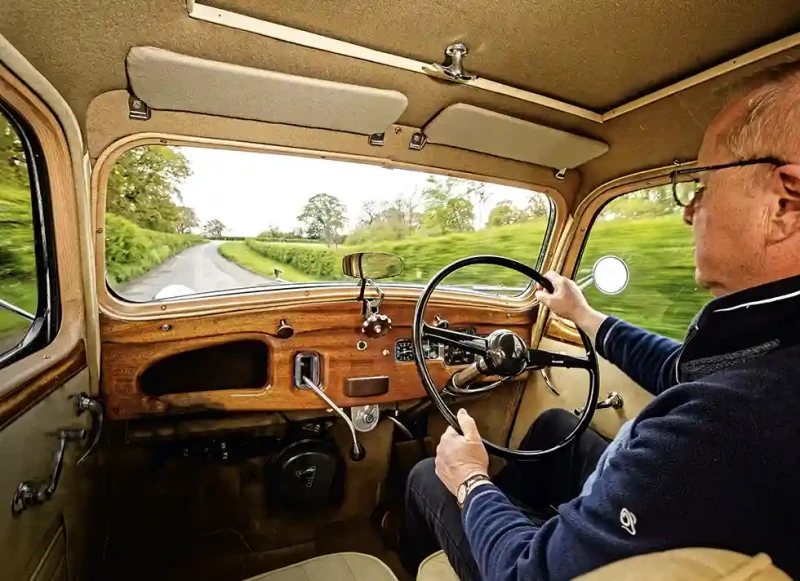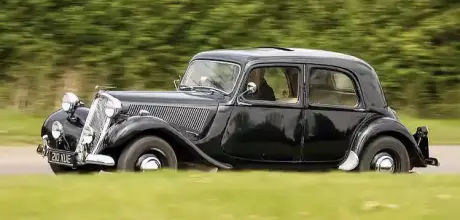1950 Citroën Light 15
Martyn Dennis is no stranger to pre-war classics, but until now he hadn’t had the opportunity to drive a Citroën Light 15 – so we’ve put that right.
Words JAMES PEENE
Photos ANTHONY BAKER
‘It’s without doubt a beautiful, charismatic and iconic car to drive’
We put a reader in this pioneering monocoque, FWD Citroën

The owner of this Citroën Light 15, Jack Peppiat, provided detailed instructions to find his house in the event that my sat-nav has a hissy fit on the twisty lanes leading up to it. He needn’t have worried; with five minutes to go to my ETA, there’s an unmistakable chevroned Citroën grille heading towards me deep in the Oxfordshire countryside. Quickly forming the conclusion that there can’t be two of these iconic machines in this neck of the woods, and that I’ve missed my turn, I pull over only for the big Citroën to turn around and head back in the direction from which it came. I follow and pull into the drive behind it to see owner Jack stepping out of the driver’s seat and Classic Cars reader Martyn Dennis emerging from the passenger side.
‘I couldn’t wait,’ Martyn admits with a grin. ‘I’ve met Jack before and was keen to get here, avoid the traffic and look over the car – so arrived early. I hope you don’t mind’.
Swinging the rear-hinged door open and settling himself down into the driver’s seat, Martyn makes his first observation. ‘Without a transmission tunnel running through the car it has a totally flat floor, so there’s lots of room inside, even in the back. That’s the beauty of front-wheel drive.’

After giving Martyn a few minutes to acclimatise to his new surroundings, I ask if he has any trepidations about the drive. ‘No. None at all. I noted that Jack has added a buzzer to the indicators, which is good. A lot of old, pre-war cars don’t have self-cancelling indicators, so you can miss the warning light and carry on indicating. Leaving the flashers on can be misconstrued and you can cause all manner of problems for yourself on the road. For a couple of quid, the audible buzzer is a really sensible addition.’ Cearly Martyn has some experience of early motoring. ‘I’ve owned around 50 cars,’ he reveals, ‘but only one French car, a Simca Monterey. It was a more upmarket Aronde but still a very lacklustre car. Its main benefit when I owned it back in the swinging Sixties was its front bench seat and column gearchange. It was a very accommodating car.
‘I’ve always been a fan of the Light 15 and I think Jack has the best of the bunch. It has the spare wheel on the back and the four-cylinder 1911cc engine so it’s very easy to get spares for. A colleague of mine had a similar one that had been owned by The Kinks, although I think it was mainly Dave Davies that drove it. Martyn traces his interest in cars from the Thirties and Fifties to his father, who owned an assortment of pre-war machinery.
‘He had a saddlery and leather goods shop, and out back there were five old stables that he used as garages. He wasn’t happy until all five garages had cars in them. He had a mechanic friend so wasn’t afraid to go for the weird and wonderful, so consequently had a Delahaye, a Minerva and a Tatra T87.’ Among the other cars in Martyn’s current collection is a 1931 Riley 9hp Biarritz, so he has been looking forward to seeing how the experience of driving this Citroën compares. ‘When Riley produced its RM model it got hold of a Light 15 to evaluate, and I think some of its design made it into the Riley.
‘Once you get used to the Citroën’s oversized steering wheel, it’s lovely. I’d say it’s got the biggest wheel on any car I’ve ever driven. It’s even larger than one that was fitted to my old straight-six Dodge and I thought that had a big wheel. This is huge, probably for the low-geared steering, but it feels nice and light considering this is quite a large vehicle. It’s a bit like a Series Land Rover. There’s a lot of movement in the straight ahead but it’s only three-and-a-half turns from lock to lock.

‘I have to say, it does feel nice and compact inside, but still roomy, with lots of light and an airy feel. Like any car, the driving position takes a bit of getting used to. I’m finding I have to really point my toes to reach the pedals. There are no seatbelts, which some people might find a bit disconcerting but I’m OK with – although I am finding the gearbox really doesn’t like to be rushed if you want it to go into gear smoothly.’
Despite feeling the car to be well-engineered overall, Martyn finds this gearbox a little difficult to gel with. ‘The three ratios are nicely spaced, but it’s quite a stretch to reach the lever. It’s almost on the other side of the car, which leaves me wondering if the shifter is in the same place as it would have been for a lefthand- drive car.’ He’s right – the knob is certainly positioned with the continental driving position in mind.
‘There’s a tiny little rumble which Jack told me is from the clutch, and there’s the slight crunchiness as you shift out of first, but there’s only synchromesh on second and third, not first.’ The lack of synchro on lower gears isn’t standing in the way of a smooth and lovely drive. ‘I’ve driven so many pre-war classics over the years that I’m used to double declutching, but Jack said there’s no need in this as long as I take it easy. It’s without doubt a beautiful, charismatic and iconic car to drive, and I’d quite happily live with something like this, especially when the weather is like it is today. Or, when the weather is bit inclement, and you don’t want an open car but can wind the sunroof back.
‘I’m not really putting the suspension to the test, but the road holding is really impressive. It soaks up all the bumps and undulations without any bother, like most French cars at the time had to do in order to cope with the roads over there.’

There’s something memorable about riding in car like this, and soon Martyn is recalling the images that define the Light 15’s heritage. ‘The Light 15 is an iconic part of the French motoring landscape. Do you remember the Athena poster company?
They made quite a few black-and-white posters with them in Paris. I’ve got one in my library at home. Interestingly, when I mentioned that, Jack said the shops they photographed outside of were all on The Kings Road in Chelsea. Somebody recently researched all that and found all the locations’. The only Athena poster I remember is the arty shot of the female tennis player, which I discover was also shot on The Kings Road. Every day is a school day when you drive a classic and the Avant is getting plenty of attention, smiles and thumbs up from other road users as we hit school-run traffic.
‘It’s clearly more of a tourer,’ says Martyn as we thread our way along busier roads, ‘so I wasn’t expecting fantastic performance, but it does accelerate nicely in second on a flat road. It feels perfectly happy cruising along at normal speeds, and the brakes inspire confidence – although I do keep giving them a jab just to test them, because you never want to rely on old brakes. On today’s roads you can’t go fast anyway, and this is more than capable of keeping up with traffic. A lot of vintage cars have a long body shape and almost caravan-like extensions on the back; fortunately, this has got jolly good mirrors, so I’m always aware of what’s going on around me.’
As an ownership prospect, it wouldn’t take much to persuade Martyn to add one to his collection. ‘It feels like great value, and I think you could pay a lot more and still not have such a rewarding motorcar. I just need to find a big shop window to see what we look like as we’re driving past’.
He isn’t wrong. There’s much to admire about this car and many of its finer details set it apart from the Avant herd. Being right-hand drive, this Britishbuilt example of the range nicknamed Traction Avant rolled out of Citroën’s Slough facility. The steering wheel on the correct side for the UK and British Commonwealth market and once returned to his driveway, owner Jack gives us the gen. ‘Citroën was the first company to move onto the Slough Trading Estate, which was built by the Government during the First World War.
All the equipment from the war that came back from France was rebuilt there and sold. Lots of young [Want a Drive?] men who returned had learnt to drive, so they bought lorries and started their own businesses.
‘Citroën was at Slough from 1926/27 through to the late Sixties and imported car bodies and engines, but there was a law concerning import tax, which meant that if less than 40 per cent of a car was sourced in the UK, companies had to pay quite hefty import levies. To get around this, Citroën fitted lots of British made parts. Such as the hubcaps and all of the electrics, which are by Lucas. Windscreen wipers, sidelights and headlamps too. ‘British Avants are all 12-volt too, whereas French ones were all six-volt, which I find makes them slightly less useful. ‘The wheels and bumpers were made by Rubery Owen and they also installed a sunshine roof, leather interior and wooden dashboard which French cars never ever had.’
Martyn reckons this is the best model of the lot, and Jack agrees. ‘I like it a lot. The only nicer bit about the French cars is that on the earlier models you got a seat with a chrome rail across the back of them, so when you’re getting in and out you have something to grab hold of. Their door handles also have a curve in them and the front bumpers curve down in the centre.’ Avants came in three body sizes, with this, the Légère being the smallest. There was also a Familiale model – four inches wider and longer – and even a Limousine with three rows of seats. Citroën also built a long-wheelbase version, called the Commerciale. All will keep up with modern traffic and do all the things you could possibly want, as Jack attests.
‘My Wolsley Hornet was made in 1934 and it’s a different beast altogether. It’s hard to believe that these two cars were produced at the same time. For long-distance driving the Citroën is my goto vehicle. I’ve taken it to Belgium and Spain, and while I was on the motorway in France last year I remember saying to my partner, “Actually, I think 74mph is probably enough.”’
For Martyn, experiencing the Light 15 has been an eye opener. ‘The first time I saw this car was from a distance at Bicester Scramble, but I didn’t get a chance to talk to Jack then. I mistakenly thought his car was the poor relation of a French Avant, but now I’ve been shown the error of my ways. This is a superb car and it has definitely lived up to my expectations. It’s a very useable classic of almost the same vintage as myself. ‘It’s been wonderful to drive and I’d certainly love to own one, if I had the room to keep it and could find one as lovely as this.’
TECHNICAL DATA 1950 Citroën Light 15
- Engine 1911cc four-cylinder, ohv, Solex PBIC carburettor,
- Max Power 55.7bhp @ 4250rpm
- Max Torque 90lb ft @ 2200rpm
- Transmission Three-speed manual, front-wheel-drive
- Steering Rack and pinion
- Suspension Independent front and rear with torsion bars
- Brakes Drums front and rear
- Weight 1118kg (2464lb)
- Performance Top speed: 76mph
- Acceleration 0-60mph: 22.1sec
- Fuel consumption 24mpg
- Cost new £685
- Classic Cars Price Guide £4000-£21,000
The distracting view you’ll see reflected in shop windows as you drive past.
‘It soaks up all the bumps without any bother’
Chris and James examine the conventional four-cyl engine Access couldn’t be better, and parts aren’t too hard to find
‘It has a totally flat floor so there’s lots of room inside’
An elegant layout, despite the slightly awkward gear lever Clayton heater isn’t the only similarity with early Land Rovers.


